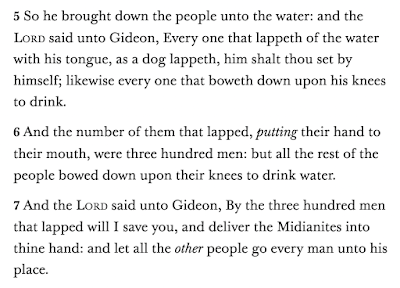My last two posts have discussed the scriptural content of Judges, and science ideas that link to the text that could be the basis for my next Primary lesson. In this post, I'll work up these science ideas into a lesson plan.
There are several stories in Judges, but two of the verses that inspired ideas were in the story about Gideon, the farmer who led 300 soldiers to victory against the Midianites. Gideon was a young man who helped his father to harvest wheat (Judges 6:11), who one day lamented the repression of his people by the Midianites, and asked "Oh my Lord, if the Lord be with us, why then is all this befallen us? and where be all his amiracles which our fathers told us of". An angel conveyed that Heavenly Father was impressed with him, appearing in front of him and saying "The Lord is with thee, thou mighty man of valour" (Judges 6:12).
Gideon didn't immediately trust in Heavenly Father, and he asked for proof that He existed. In this case, Heavenly Father obliged and did the following:
- He made fire emerge from a rock on which Gideon had put a kid goat and some unleavened bread (Judges 6:19-21).
- He made a woolen fleece wet with dew, and the ground beside it dry. (Judges 6:37-38)
- He then did the reverse, and kept the fleece dry whilst the ground collected dew. (Judges 6:39-40)
A dew creation experiment
This Mission Bible Class post discusses this fleece story, outlines a simple activity to illustrate it, and discusses how it's a slippery slope to keep asking for proof of Heavenly Father as a basis for your faith, because it'll continue to require "topping up" with additional proof, as Gideon did with his three separate requests. It's actually a nice resource post, as also it features a slide deck illustrating the story, and other activity ideas at the bottom. I like the idea about collecting different fleece / fabric samples and letting the children test how they absorb water differently. (There's also a great post on their site about how to adapt teaching methods to different age groups, including the 8-10 year old age group that I teach.)
It's better to build up a faith without relying on tangible proof, and we can use a simple science experiment to illustrate the existence of things that we can't see or touch. In this simple dew creation experiment, you take two glass cups of water, fill one with ice, and leave them for 10-15 minutes. It's something that we could set up at the start of a lesson, then revisit at the end, or perhaps even have one started off before the lesson begins. After some time has elapsed, the cup containing ice should have a thin layer of water droplets on the outer surface. This occurs because water vapour, which is in the air around us, touches the cold cup surface, cools down, and turns from gaseous to liquid form and condenses on the cup surface.
This experiment may not work as well in a very dry environment, unless you can create a closed environment (e.g. with a large clear perspex box) with a wet towel to simulate a humid environment. That would actually be a nice extension of the experiment, if you did this twice, once without and once with the wet towel, to show that the condensation effect relies directly on the presence of water.
Dog water lapping
We could then discuss the next part of the Gideon story, where he has to find a small trustworthy group of followers for his army. This is described in Judges 7:4-7. In particular, one requirement in the selected followers is that "Every one that lappeth of the water with his tongue, as a dog lappeth, him shalt thou set by himself." In other words, whoever obeys the directive to get down on all fours and drink the water doggy-style will be deemed worthy enough.
I found a really interesting article on the science of how dogs drink water. This LA Times article summarises the process. It was originally thought that dogs would scoop up water with their tongues, however calculations suggest that this can't provide enough water to meet a dog's requirements. A study with high speed cameras showed that they drink water through a different mechanism.
This video sequence from the main research paper, which was published in PNAS in 2015, shows how dog lapping works. The tongue acts as a finely tuned battering ram that pushes down against the water at a speed of 4 mph. As it withdraws, it creates a pressure gradient between the tongue/water interface and the water's surface, which causes a column of water to rebound up into the air. This can be caught by the dog's mouth as it retracts its tongue. All of this happens in the space of milliseconds, and can be replicated using a glass rod experimental setup that's described in the paper. This YouTube video of slo-mo dog drinking shows the generation of the pressure gradient really nicely at the 1:20-1:24 point.
High speed camera photos of a dog lapping water, from Figure 1 of the PNAS article "Dogs lap using acceleration-driven open pumping" (2015).
We can relate this to the story in Judges 7:5-7.
The men who got down on their knees to drink were excluded, and those who lapped the water were retained. The reason for this isn't clear and has generated quite a bit of debate (e.g. this Quora thread). We could suggest that there's a symbolism in the dog lapping mechanism, which relies on physics and faith to send the water up to where it's needed.



Comments
Post a Comment